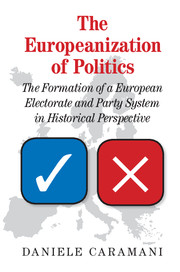 The Europeanization of Politics
The Europeanization of Politics Book contents
- Frontmatter
- Contents
- List of Figures
- List of Tables
- Preface and Acknowledgements
- List of Abbreviations
- Introduction: Electoral Integration in Europe
- Part I Framework
- Part II Analysis
- 3 Homogeneity: Convergence and Deviation in European Electoral Development, 1848–2012
- 4 Uniformity: Electoral Waves and Electoral Swings across Europe, 1848–2012
- 5 Correspondence: Overlapping versus Distinctive Electorates in National and European Elections, 1974–2012
- 6 Cohesion: Ideological Convergence within European Party Families, 1945–2009
- 7 Closure: The Europeanization of Cabinet and Coalition Politics, 1945–2009
- Part III Assessment
- Conclusion: Towards Europe-wide Representation
- Appendices
- References
- Index
5 - Correspondence: Overlapping versus Distinctive Electorates in National and European Elections, 1974–2012
from Part II - Analysis
Published online by Cambridge University Press: 05 November 2015
- Frontmatter
- Contents
- List of Figures
- List of Tables
- Preface and Acknowledgements
- List of Abbreviations
- Introduction: Electoral Integration in Europe
- Part I Framework
- Part II Analysis
- 3 Homogeneity: Convergence and Deviation in European Electoral Development, 1848–2012
- 4 Uniformity: Electoral Waves and Electoral Swings across Europe, 1848–2012
- 5 Correspondence: Overlapping versus Distinctive Electorates in National and European Elections, 1974–2012
- 6 Cohesion: Ideological Convergence within European Party Families, 1945–2009
- 7 Closure: The Europeanization of Cabinet and Coalition Politics, 1945–2009
- Part III Assessment
- Conclusion: Towards Europe-wide Representation
- Appendices
- References
- Index
Summary
Introduction
Correspondence refers to the overlap or, conversely, the distinctiveness between the two levels of elections in Europe, national and supra-national. This chapter investigates the extent to which there is a distinct electorate and party system at the EU level, independent from national issues, party platforms, and alignments. The vertical correspondence of electoral behaviour between national and European elections is analyzed through a comparison of national elections and elections to the EP. Is there, and, if so, to what degree, a differentiated European party system or, on the contrary, is electoral behaviour in European elections a reflection of national political contests? And is there a trend in the progressive “emancipation” of the European party system from national politics over 30 years of European elections? This chapter investigates the origins of distinctiveness based on swings towards and against party families based on the previous chapter.
Since the first direct elections to the EP in 1979, European elections have been described as “second-order elections” (Reif and Schmitt, 1980). This label implies not only that European elections are (perceived as) less important than national elections in the member-states of the EU, but also that European elections are dominated by national factors. European electorates vote for the EP according to national criteria, campaigns are run on national issues, voters are guided in their voting choices by national party affiliations and electoral alignments, and leaders seek support on national policies and platforms. In sum, European elections are national contests “by other means”.
Over the past 30 years the EP has acquired new competences and strengthened those it already had. Decision making is systematically affected by European party federations, and groups consolidated in the EP. More generally, the process of integration has moved at an accelerated pace and public debates have gained strength in the wake of referenda on accession, common currency, and treaties and with the process of the EU's “constitutionalization”.
- Type
- Chapter
- Information
- The Europeanization of PoliticsThe Formation of a European Electorate and Party System in Historical Perspective, pp. 149 - 185Publisher: Cambridge University PressPrint publication year: 2015


